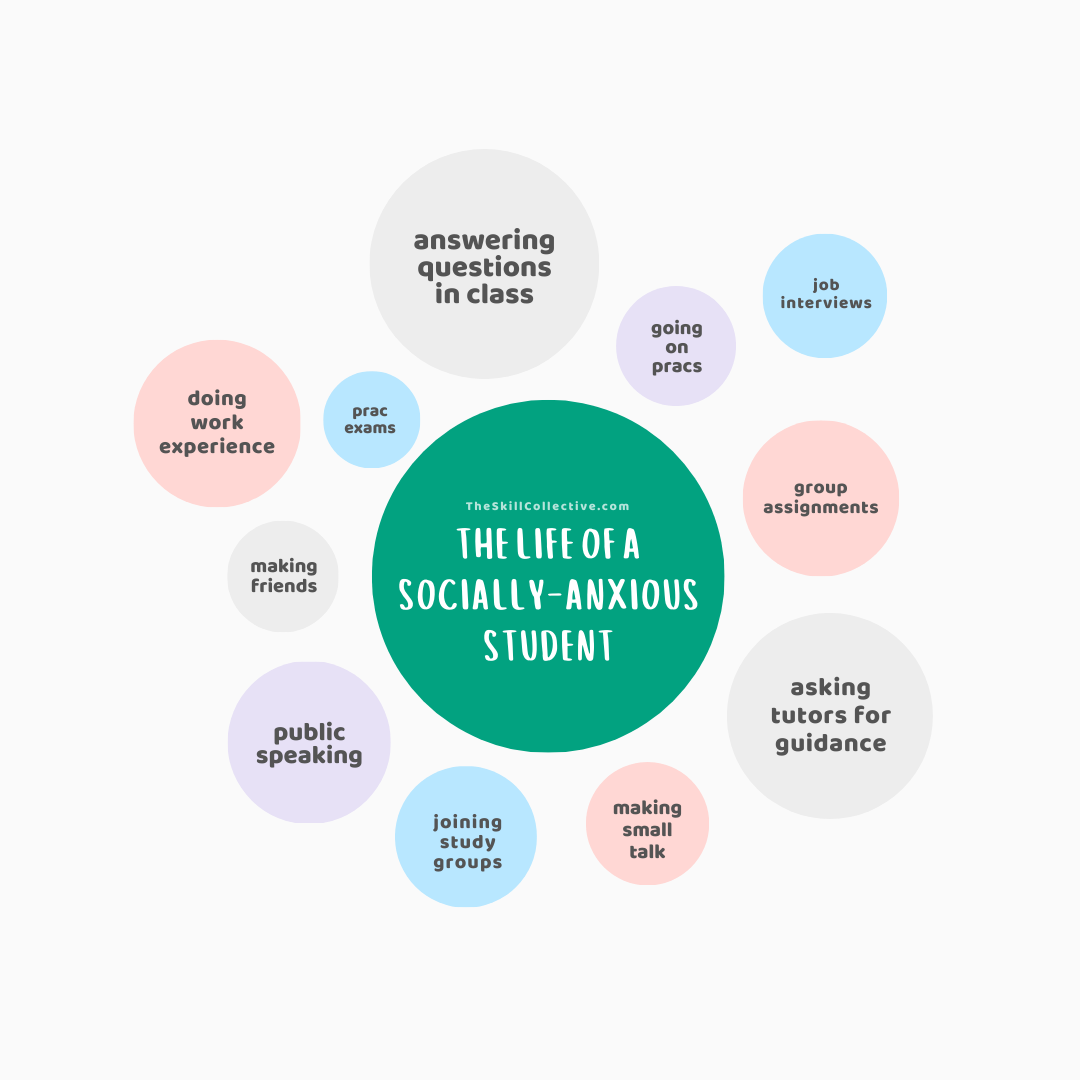Adults with social anxiety disorder typically experience intense fear during social interactions and worry about being judged by others. Common symptoms include trembling, sweating, and difficulty speaking.
Social anxiety disorder in adults can significantly impair everyday functioning, making it more than just shyness—it’s a chronic mental health condition that affects approximately 7% of the population at some point in their lives. Characterized by overwhelming anxiety and excessive self-consciousness in social settings, this disorder is not simply being nervous about a social engagement or feeling timid.
Instead, it’s a pervasive and persistent fear that can dominate one’s life, leading to avoidance of social situations, strained relationships, and reduced quality of life. Timely identification and management are crucial for those afflicted to reclaim their lives and thrive in social contexts.
Recognizing The Hidden Struggle
Adults often battle the symptoms of Social Anxiety Disorder (SAD) silently. Signs may seem simple, but they hold deep fears for sufferers. Avoiding social events, and preferring solitude over company tell of their silent struggle.
They might feel overly self-conscious, even among friends. The fear of being judged can be overwhelming. Physical expressions of this anxiety aren’t always obvious, like subtle trembling or slight sweating.
Some avoid eye contact or become unusually quiet. A shaky voice or blushing can happen, too. These are the subtle cues of discomfort to notice.
Let’s be kind and understand their private battle of social avoidance. Once spotted, we can extend support to those in need. It starts with seeing beyond the subtleties.
Bodily Responses
Adults with social anxiety often face a common issue: uncontrollable blushing. This sudden redness of the face can happen in social gatherings or even at a simple compliment. This response is a clear sign of discomfort or embarrassment, making it hard for them to stay in the spotlight.
Alongside blushing, nervous sweating is another physical symptom. Palms might get damp or the entire body might break out in sweat. This unwanted sweating is distressing and can occur even in cooler environments. It’s not just about being hot—it’s a response to extreme stress and anxiety.
The Cycle Of Fear And Embarrassment
Social anxiety disorder (SAD) grips adults with a tenacious fear of being interpreted negatively. Facing judgment and embarrassment becomes a daunting ordeal. This often translates to an intense dread of criticism, leading to an overwhelming urge to avoid potentially uncomfortable interactions.
Adults with SAD engage in avoidance behaviors, shying away from places where they might be under social examination. Everyday activities like meeting new people, speaking in front of groups, or even dining out can trigger significant anxiety. Such actions are sidestepped to evade the discomfort of being scrutinized or ridiculed.
Communication Challenges
Adults with social anxiety often find it hard to look others in the eyes. A simple gaze can feel overwhelming. Eyes shifting away can happen even during short talks. This makes connecting with people tough.
Under stress, not just eye behavior changes. One’s voice can take on a different tone or pitch unexpectedly. Speaking may become faster or shaky, making conversations hard. Breathy or quiet voices are common signs too.
Physical Symptoms
Adults with social anxiety often feel their hearts beating fast during social interactions. This accelerated heartbeat is scary. It’s like a drum pounding in their chest. Sometimes, it’s loud. Others might not hear it, but it feels very loud to them.
Tremors or shaky sensations are common too. Hands may shake. The shaking makes holding things hard. Coffee might spill. Signing names becomes a challenge. It’s not just the hands. The whole body might tremble. These signs are stressful. They tend to happen more in social settings.
Gastrointestinal Reactions
Social anxiety can cause stomach issues like nausea or an upset stomach. These are common symptoms for many adults facing social fears.
The link between anxiety and diarrhea is strong. Feeling nervous may lead to stomach pain or the need to use the bathroom often.
Mental Blocks
Adults with social anxiety may struggle to find words in conversations, leading to a blank mind. This mental block can cause discomfort and a desire to escape social settings. Professionals label this as one symptom of Social Anxiety Disorder (SAD).
Overthinking after social situations is another common sign. Individuals may replay interactions and criticize their behavior. They worry that they might have made a mistake or left a negative impression.
No conclusion paragraph is included as per the guidelines.
Avoidance Patterns
Adults with social anxiety disorder often avoid gatherings. Parties and meetings can trigger a strong fear of judgment. This leads to missing out on social, academic, or job opportunities. The thought of attending can cause significant distress. Shunning events becomes a protective behavior. Yet, this self-preservation tends to reinforce the anxiety.
Crucial connections are often not formed due to this avoidance. The individual may struggle to advance in personal or professional spheres. Relationships are harder to build and maintain. Missed events can mean fewer shared experiences with others. Such patterns of avoidance can limit one’s growth and overall life satisfaction.
Coping With Alcohol
Adults with social anxiety often find solace in alcohol. This method of coping can lead to addiction. Alcohol as a crutch masks social fears temporarily.
The risks of substance use include worsening anxiety over time. Relying on substances also damages relationships and work life.
Alcohol can create a cycle of dependence. It changes how one handles social interactions. This leads to isolation and increases anxiety.
| Substance | Short-term Effect | Long-term Impact |
|---|---|---|
| Alcohol | Temporary relief | Social withdrawal |
| Drugs | Escape from reality | Worsened anxiety |

Credit: theskillcollective.com
Long-term Consequences
Social anxiety disorder in adults can lead to serious long-term issues without treatment. One major concern is the potential for social isolation. Adults may find themselves avoiding social interactions, leading to a lack of friends and support.
This avoidance can trigger a downward spiral into depression. Frequent feelings of loneliness and sadness may dominate. Enjoyable activities become less appealing as isolation takes hold. Adults need to seek help to prevent these severe consequences.
Identifying Triggers
Many adults with social anxiety disorder find certain scenarios challenging. Public speaking can be a nightmare. Walking into a room full of people might feel impossible. Even a simple phone call may cause a panic attack. Eye contact becomes a battle. And the fear of judgment looms large.
Recognizing personal fears is critical. It seems scary, but it’s the first step towards managing them. For some, eating in front of others triggers intense anxiety. Others might dread job interviews or business meetings. Joining a conversation can be a source of stress.
Many avoid these situations, but avoidance only strengthens the fear. Seeking professional help to identify these triggers is often beneficial.
:max_bytes(150000):strip_icc()/what-is-adhd-masking-5200863_final1-5bdf8d510df043acb02181cdc43a3719.png)
Credit: www.verywellmind.com
Seeking Help
It’s vital to seek a professional if social anxiety disrupts daily life. Persistent symptoms, like intense fear in social settings, should not be ignored.
Early intervention can prevent the disorder from worsening. Constant worry about embarrassment or judgment in everyday interactions is a clear sign.
Consult a doctor if anxiety leads to avoidance that hinders work, school, or personal relationships.
| Offers support, and hones social skills in a safe environment. | Key Benefits |
|---|---|
| Cognitive Behavioral Therapy (CBT) | Improves thought patterns, reducing anxiety triggers. |
| Exposure Therapy | Gradual exposure to fears to build confidence and coping skills. |
| Group Therapy | Offers support, hones social skills in a safe environment. |
| Medication | Can regulate symptoms, used alongside therapy. |
| Self-help Strategies | Deep breathing, mindfulness can manage in-the-moment anxiety. |
:max_bytes(150000):strip_icc()/extreme-anxiety-symptoms-types-treatments-and-coping-5201901-1500x1000-Text-Final-7d0723a651c54f279c2cdf52772a5bed.png)
Credit: www.verywellmind.com
Frequently Asked Questions For What Are The Symptoms Of Social Anxiety Disorder In Adults
How Does A Person With Social Anxiety Act?
A person with social anxiety may avoid social situations, fear judgment, struggle with making eye contact, and exhibit physical signs of anxiety like sweating and trembling.
What Are 3 Symptoms Of Social Anxiety?
Social anxiety symptoms include intense fear of social interactions, worry about being judged or embarrassed, and avoidance of social situations.
What Makes Social Anxiety Worse?
Excessive criticism, humiliation, and over-pressurized social interactions can exacerbate social anxiety. Unaddressed fears and stress also contribute significantly.
What Happens If Social Anxiety Is Left Untreated?
Untreated social anxiety can lead to an increased risk of depression, isolation, and a lower quality of life. It may also result in reliance on substances like alcohol.
Conclusion
Recognizing social anxiety disorder’s symptoms can mark the first step toward seeking help. Adults with this condition often grapple with fear of judgment, and physical signs of nervousness, and may avoid social situations altogether. It’s essential to consult a healthcare professional if these signs resonate with you.
Taking action can lead to effective management and a better quality of life. Remember, support is available and you’re not alone.
